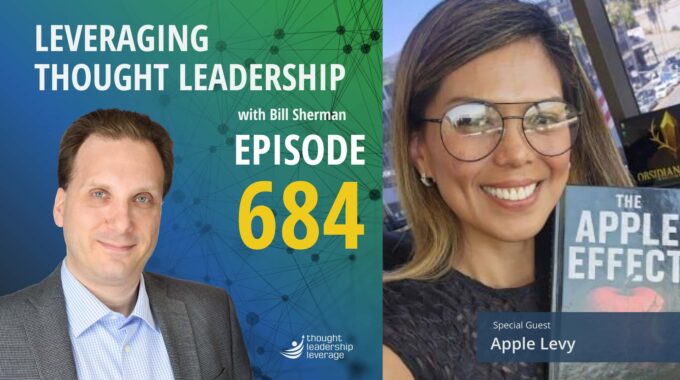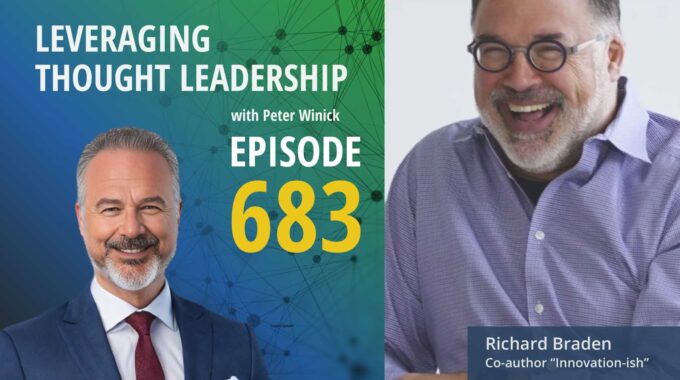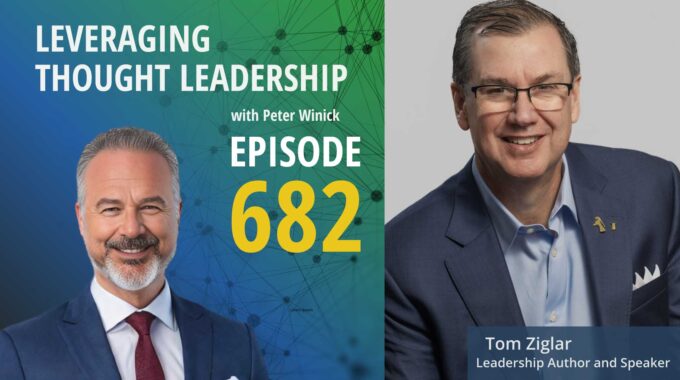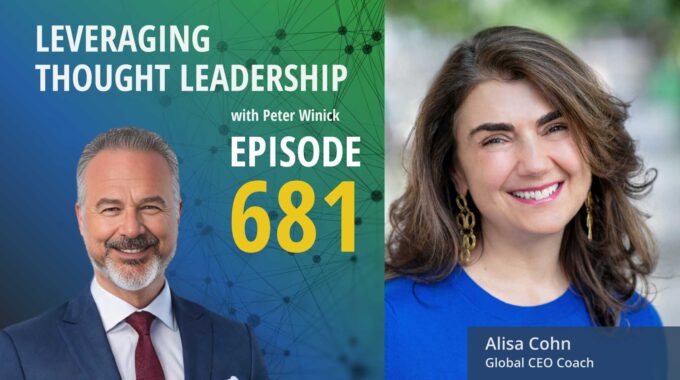A field-tested framework for leaders who want better margins, cleaner operations, and a stronger culture…
Matching Journalism with Thought Leadership Consulting | Adam Bryant
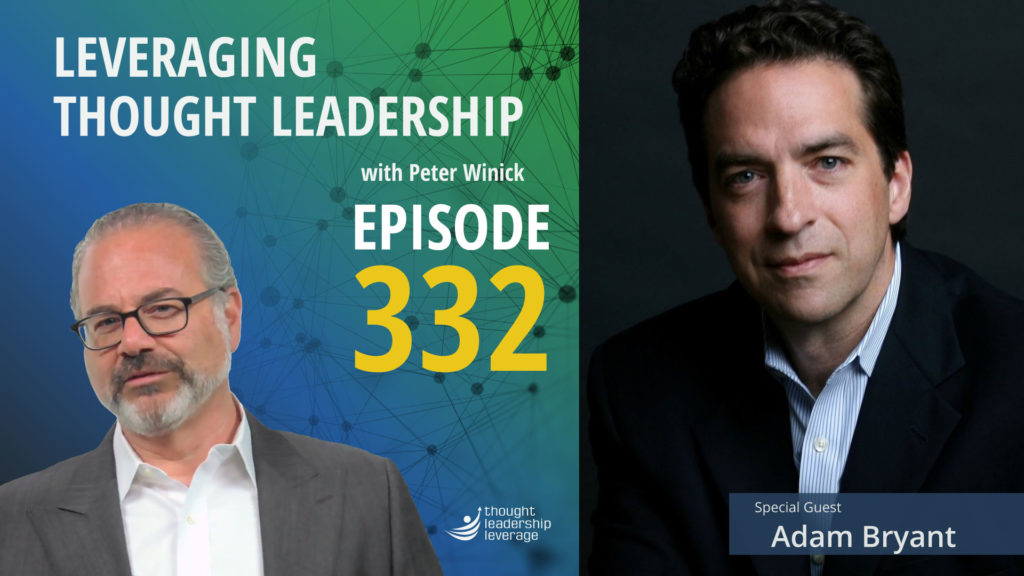
Using External Career Skills in Your Thought Leadership
An interview with Adam Bryant about using journalism and editing skills on the path of becoming a respected thought leader and consultant.
Today’s guest is Adam Bryant, Managing Director at The ExCo Group (formerly Merryck & Co. Americas). The Exco Group specializes in helping boards, executives, and teams unlock their full leadership potential and deliver high-impact performance for their enterprises. Adam is also the author of The CEO Test: Master the Challenges That Make or Break All Leaders; a book that focuses on the seven most critical reasons leaders succeed or fail.
Adam hasn’t always been a thought leader. For 30 years, he had a successful career as a journalist, editor, and columnist, primarily at The New York Times. As he honed his communication skills and learned the ins-and-outs of complex teams, Adam focused on the question: “What if we interviewed a CEO for an article and didn’t discuss their business background?” Instead, he focused the conversation around the lessons of leadership, culture, hiring, and talent, to see what made high-powered leaders flourish and grow.
Over 10 years, Adam interviewed 525 CEOs. Those lessons eventually became a book: The Corner Office: Indispensable and Unexpected Lessons from CEOs on How to Lead and Succeed. In it, he presented the insights and advice he gleaned through those interviews in order to to help others master the steep learning curve of leadership.
In today’s episode, Adam discusses his skills as a journalist, and how they positioned him to elevate others through the practice of thought leadership. He credits that background with his impressive ability to see patterns, focus on the essence of an issue, and find insights in both challenges and success – and share those gifts with others. If you’re feeling blocked, this is the episode that can show you how to find your strengths and bring them into the game!
Three Key Takeaways:
- Non-traditional questions can be a great way for thought leaders to gain new insight.
- Thought leaders can find strong, accessible examples of leadership lessons in TV and movies.
- Thought leadership might start out as a “side-hustle,” but if nurtured properly, can take on a life of its own!
If you need a strategy to bring your thought leadership to market, Thought Leadership Leverage can assist you! Contact us for more information. In addition, we can help you implement marketing, research, and sales. Let us help you so you can devote yourself to what you do best.
Transcript
Peter Winick And welcome, welcome, welcome, this is Peter Winick, I’m the founder and CEO at Thought Leadership Leverage, and you’re joining us on the podcast today, which is Leveraging Thought Leadership. I’m very excited about today’s guest. Today’s guest is Adam Bryant. Adam is currently the managing director of American Co., which is a senior leadership development and executive mentoring firm. Prior to that, Adam worked for 30 years as a journalist, including 18 years as a reporter, editor and columnist at The New York Times. I feel like I spend every Sunday morning for many years reading the Corner Office column, which then became a book. And you’ve written two books since then. The most recent book is the CEO Test Master The Challenges, The Make or Break All Leaders, published by Harvard Business Review. So welcome aboard, Adam. Thank you for spending some time with us.
Adam Bryant Thank you, Peter.
Peter Winick So I want to sort of talk about your path because it’s an interesting one. So journalist, author, advisor, and then you sort of crossed over to the dark side or the light side, depending on the perspective, of the business side of this. So sort of tell me, tell me the Adam story a little bit.
Adam Bryant Sure. I guess it goes along two tracks. I mean, from the time I was in my early 20s, I wanted to be a journalist and dreamed of someday working at the New York Times and got there when I was 29, spent 10 years as a reporter, went to Newsweek magazine as a writer, then went in the editing side, went back to the Times for 11 years, and during those 11 years, I was an editor on many desks, always running teams of reporters. But in 2009 I started this side project called Corner Office.
Peter Winick Beware of side projects. Because I heard more thought leaders say it started at this random — you know this thing right?
Adam Bryant Exactly. You got your day job and then you go to the side hustle.
Peter Winick Yeah.
Adam Bryant So Corner Office was launched on a on a very simple what if? Which is what if I sat down with CEOs and never asked them a single question about their companies and instead just asking about leadership lessons they’ve learned over the course of their lives and how they think about these sort of timeless themes about culture and hiring and talent. And so that, you know, I was doing that while I was doing my day job. Never missed a week over a decade, interviewed five hundred twenty-five CEOs, wrote a couple of books, started teaching and just kind of reached a point where I wanted to turn the side project into my day job. And it was a pretty natural transition by the CEO of my current firm was one of the five hundred and twenty-five CEOs I interviewed. So that’s how I met him. And, you know, ultimately it’s about helping people shorten the learning curve of leadership. And that has, for me, been the kind of through line that if I can interview leaders and get them to share their best stories and insights and tools and tips, that maybe that helps make some people better leaders.
Peter Winick So what I always found interesting about the Corner Office is, you know, most of what you’d read in the Sunday business section of the times, or any of the sections, is the stuff you’d expect company a company B earnings came out that said, you just said this blah blah blah, etc. But the stuff that you asked it was always interesting and you pointed out you never asked them about their business. You would ask them, what was your first job as a kid? And they tell you, you know, they were cleaning barns or, you know, who influenced them and, you know, single parent or whatever. And it helped understand it helped people understand sort of the humanity underneath it or what drove them, or in some cases, sort of the some of the dysfunctions that they overcame to get to where they are that weren’t part of the public persona. So I think that theme was really intriguing.
Adam Bryant Yeah. And part of the insight for me was that the business press pretty much always interviews CEOs as strategists. It’s almost like football coaches, right? Like, how are you going to win this Sunday? And what about the other team? And that’s fine. And you know, football coaches, you know, spend all their time thinking about leadership, but people rarely asked them about that. It’s all about the results. And so, yeah, and part of that insight for me, I mean, I was a business reporter for many years, interviewed a lot of CEOs through that kind of traditional lens. Tell me about the industry and your strategy. And I just found during the course of those interviews, I started thinking, It’s like these people seem really smart, you know, fast brains, good sense of humor. Some wisdom. Like, what if we just set aside all those usual questions and basically say, like, how do you how do you do what you do and how did you learn to do what you do?
Peter Winick Or sometimes, why do you do what you do?
Adam Bryant Exactly. And you know what’s interesting for me? You mention the word humanity. Every week I had this little kind of experiment of like, what are the questions I can ask? What are the best questions that will get them off their scripts and help me understand them? And over time, I just developed the system that I always started with the same three questions. Tell me about when you were a kid. Like what you’re doing outside of class? Tell me about your parents or whoever raised you like, what did they do? And then the third question was How have your parents interviewed your story influenced your leadership style today? And I always felt, Peter, once I had the answer, those three questions. It’s like, I got you. Like, I understand just where that sort of intrinsic motivation comes from, because —
Peter Winick It must have driven some of the Corp. Com folks nuts because they’re used to giving them. Here’s the five bullets and it doesn’t matter what they ask you. They think the answers to every question, are “We’re growing this year, our KPI is this,” you know?
Adam Bryant Exactly. I mean, it was refreshing to me when the PR people would sometimes turn to me and I’d always do the interviews in person. They would often bring a PR person and they would turn to me and say, I couldn’t prep my CEO for this interview. It’s like, that’s a victory.
Peter Winick Exactly, exactly. So talk about it from the standpoint of your journey as a thought leader. Right. So I understand it’s a different business. Models of being a journalist is a business model. You write, you get paid, sometimes right, sometimes more than others. How did you decide to transition onto the other side? Obviously, you mentioned you met the CEO of Merck as one of your interviewees. But what was it about you sort of going over to the other side of the leadership development in such that that Merck does? That was intriguing to you?
Adam Bryant Well, part of it. You know, I had developed a sense of how things work through my hundreds of interviews, but it’s been a great new chapter in my learning curve has been wonderfully steep to go inside these large corporations and to work directly with leaders and leadership teams. And that’s the good news is that’s only kind of reinforced my understanding and insights about some of the broader leadership challenges. You know, I have to say I’m still very much using my journalism muscles. I’ve got four interview series going on LinkedIn with board director CEO CHROs. And you know, I just wrote this book, I write a monthly column and ultimately to me, I’d probably say the through line, Peter is just, you know, I sometimes think my only skill in life is pattern recognition that, you know, if you show me like five hundred things like, I’ll start noticing the patterns. And because with my approach, with my interviews is always just ask these super open ended questions, you know, then you know, at this point, I’ve got like about six million words from all the transcripts that I’ve done. And you know, to me, at some point that qualitative day data becomes quantitative and the patterns emerge.
Peter Winick So stay there a second, because I think that and I’ve seen this before. There are a lot more similarities than one would think in a top rate journalist and a top rate consultant. How they answer questions. How they put on my consultant hat. What does a great consultant do right? They ask the right questions. They get to the heart of it. They understand the patterns that they do have frameworks, processes, methodologies, et cetera, that they draw on. But I think there’s a piece in one of my downside to being a consultant as I see everything is a Venn diagram, and the Venn diagram of journalists to consultants is pretty strong. So when you go into the consulting side, even though that title is very different, how different were not his journalism from consulting?
Adam Bryant I think it’s awfully similar. And you just said, you know, the mental muscles are the same. It’s pattern recognition. I like what you just described as this idea of like getting to the essence of an issue. And in many ways, I feel like, you know, I was an editor for 14 years, all then worked with, you know, hundreds of reporters on thousands of stories and ultimately that muscle, you know, when you’re talking to a reporter and thinking, OK, I’m going to walk into a meeting page one meeting at the times and pitch this to 40 people, I need to get to the essence of it in my head. I need to get the 12-word pitch on this idea. And I would push the reporters in and to the point where I would finally nail that. And you know, you can call that critical thinking. You can call that getting to the essence of something. But I do find I mean, the first chapter in the book is about the simple word strategy and what that means. And so many companies go through the strategy exercise. And, you know, to be honest, Peter, it’s not really a strategy that they come up with. And it is that kind of like Editor Brain, that critical thinking, that essentially says, like, you’ve got to push their more work needs to be done to make this clear and more concise, and it needs more critical thinking to get to the essence of it.
Peter Winick If you’re enjoying this episode of Leveraging Thought Leadership, please make sure to subscribe. If you’d like to help spread the word about our podcast, please leave us a review and share it with your friends. We’re available on Apple Podcasts and on all major listening apps, as well as at ThoughtLeadershipLeverage.com forward slash podcasts.
Peter Winick So I want to touch on something else that you said because a great consultant and a great journalist also typically have a little bit of ADD and they do a little bit with a lot, right? So if I couldn’t even imagine, I mean, you just mentioned six million words, and I can’t even imagine the thousands of different of business stories that you’ve touched and you take a little bit away from that. And sometimes those patterns are interdisciplinary. Right. And one of the benefits of journalists like consultancies. Hmm. I’ve got some clients in this industry over here that my current clients never know about to talk to. You know, the manufacturing folks don’t know anything about farm in the tech. Folks don’t know anything about logistics, but you start to see things and sort of cross-pollinate that. How is that if it has played for?
Adam Bryant You know, it really has. And just the way my brain works, I mean, I do have kind of ADD. I’m interested in everything and, you know, because I’m so fascinated about leadership, I, you know, I’ve been developing this sort of library of clips from movies and TV shows that that contain, you know, a powerful lesson about leadership. But I’m often really super impressed with these TV writers because it’s like, you’ve never, you know, if you’re a TV writer, I’m not sure you’ve ever been in a corporate setting, but somehow you have this insight, you know, this fundamental insight about leadership. So.
Peter Winick And just because you don’t have to be I mean, people think that I think the default way that people think is that leadership is a corporate thing. And I think that you just, you know, a good Girl Scout troop has a leader, right? You’re, you know, a school has a leader of a team as a leader. They might not be anointed as such officially right. Leadership comes out everywhere.
Adam Bryant It does. And to me, you know what? Leadership is one of those super sprawling topics, right? At some level, leadership is about everything, and the framework that I use in my head is like, you know, when you read something, when you hear something about leadership, to me, it’s one of two categories like is it a reminder or is that a new insight or is it an insight? Because, you know, anybody can say to you, it’s like, Hey, Peter, did you know that leadership is about communication? You go. I kind of knew that, you know, it’s a good reminder. But when you see, like a clip on The Sopranos of, you know, Tony telling an intentionally stupid joke to test Carmella’s theory that people laugh at his jokes just because they work for him and him having that like slow blink of recognition, you know, that’s an important insight about leadership, which is careful how funny your jokes become as you move on.
Peter Winick And I think there’s not just The Sopranos and Goodfellas, The Godfather, some of the greatest leadership lessons. Right? I’m a New York guy that loves all of that stuff. Right. The reason we love it is I love, at least to me. It’s not just the violence and the intensity, but it’s the leadership and not the way we’re used to it.
Adam Bryant Right, right. And to me, that’s the point, because look, I think leadership is probably the most important thing, right? That’s why I’m so passionate about it, because great leaders can elevate people’s lives and organizations, and we’ve seen what bad leaders can do as well. So I think it’s hugely important. And I also think that there’s just a lot. Look, I’ll be very blunt with you, Peter. I think there’s a lot of kind of gunk in this space. Anybody can say anything about leadership and it’s not going to be wrong. I just think that people need to be a little more demanding.
Peter Winick Let me take that to where I was going. So I agree with you that there’s a lot of breadcrumbs and breadcrumbs in the leadership meatball, right?
Adam Bryant That’s good. I’ll take that metaphor.
Peter Winick I think that there you go, which leads me to sort of my focus, which is not leadership, right? So there’s lazy leadership from a thought leadership perspective, which is regurgitating or telling me something obvious or whatever, but we talk about it through the lens of thought leadership. So your new book master the challenges that make or break all leaders, I would assume, given your sort of high bar, et cetera, my leadership, there’s probably stuff in there I haven’t seen before or haven’t read before or thought of it in that way before.
Adam Bryant Yeah, I would hope so. And ultimately, you and the other readers are going to be the judge on whether we succeed. But to me, the upstream work is really important and my coauthor, Kevin and I, we did a lot of work to be really clear on the questions that we wanted to ask and answer. You know, and one of them is contained in the subtitle, which is what are the challenges that make or break all leaders? Why do people succeed or fail in these roles? And yes, you could say there’s 300 reasons, but what are the most important? Seven. That’s the discipline. The other thing that we did is like people in our society treat CEOs like they’re a subspecies of the human race, right? Like they’re different. And we said, What if we flipped that script and said, How are they the same as all leaders? What are the tests that all leaders face? And then what can we learn from CEOs on the front lines about how to do these?
Peter Winick Well, let’s stay with that because I’m trying to understand from the thought leadership perspective and what you just described, maybe intentionally or not, is smart leadership, right? So everybody assumes that a CEO is a subset of and you flip it. So you took the standard way of thinking that is not even controversial. Those are just the way of, you know, like the Earth is, the Earth is round. What if I looked at it a different way? And that’s an example of what leadership it is.
Adam Bryant And you know, in many ways, it’s to me, it’s part of the sort of the journalism muscles that I developed. And maybe they’re also the same as consultant muscles. But in all my years at the newsroom, at the times, you know, there’s this expression, the art of the good dumb question. And I think that is an important art form. But you know, that art form led me to say, what if I sit down with CEOs and never ask them about their companies? And I don’t write books because I wake up with an idea. I wake up with the question, you know, to me, it’s all about getting the question right. And there is a I’d like to think there’s a good, dumb underlying question under each of my three. Books that led me to write those. And to me, that’s part of like, what is the new question when people go like, I haven’t seen it framed that way. And on the one hand, it seems kind of obvious it’s almost like a New Yorker cartoon, right? Like sometimes when you see New Yorker, it’s like it. Hasn’t somebody done that cartoon before? That’s so obvious. So to me, that’s part of the magic.
Peter Winick No, I love that. I love it. And I think that’s the difference between a seasoned journalist or consultant and one that’s not. You can have a really brilliant young whatever and a big consulting firm, you know, a 28 year old at Accenture that has gone through an amazing training and great frameworks and great methodologies, but they haven’t built their unquestioning muscles. So they’re sort of just reading from the book, if you will, and following the playbook, which is fine in some instances, but you don’t gain the insight. The thing that’s you know, that you are one question away from the breakthrough that made a difference between a good doing a good job and doing a great job.
Adam Bryant Yeah. And you do have to spend time in whatever field to discover that sort of obvious thing, right? You know, there’s a book I made I read many years ago is just one of these classic adventure things. And there was this image that really stuck in my head talking about like they were these two guys in a canoe. They were essentially lost and going from like lake to lake. And they said, you know, what was disheartening is because you get to the new lake and you can’t see the tributaries right here. So you literally have to paddle around the entire lake to find the one way out of it. And to me, like that image stayed with me. And, you know, I sort of feel like I haven’t spent a lot of time paddling around the leadership lake looking for those kind of new little tributaries just to find out one thing. It’s like, Wait, that that’s new.
Peter Winick And sometimes it might just appear as a nuance. But then, you know, whatever you use the analogy, you paddle in deeper you’re like, Oh, wait a minute, it’s more than just a slight nuance. It makes all the difference.
Adam Bryant Right? Yeah. And for me, it’s like, Look, I’ve trained as a journalist. I can go to business school and just having spending enough time, especially now inside big companies and having this insight, it’s like, wait a minute. Strategy is a Rorschach test. It is a classic inkblot. That simple word that I used to assume meant the same thing to everybody. Everybody’s got a different opinion about it. And to me, it’s like I could only get that insight through time and experience.
Peter Winick Yeah. And it’s interesting that something as clear cut, theoretically or well-defined, I should say a strategy. People put things out to say, Tell me your strategy. Like, No, no, you just told me five tactics. Let me tell me your strategy. No, no. That’s your social media. No, no, no. OK, let’s go backwards because you don’t want to be patronizing. Well, how are you thinking about strategy? How do you define it right? It’s not a series of activities, right? That’s what I do every day. Right. And I think that for some reason in different organizations, whatever the case may be, the clarity around what strategy is and the power of a good strategy gets diluted because, you know, activity is not productive. We’re so busy doing stuff right.
Adam Bryant And to me, you know, once you once you agree that that is a phenomenon, then the question becomes, why is that? And I think there’s a couple of reasons. One is, I think people just sort of naturally go to, you know, say four things, right? Because if you’re a CEO, you know, you’re going to put your job at risk. If you have a really clear and ambitious strategy, it’s much safer to say, well, we’re going to look for high return opportunities and be industry leading, blah blah blah, right? Like, that’s not a strategy. That’s a description of what companies do. But it’s much safer. You’re sort of like, That’s our strategy. I can ride that out for like seven years, right?
Peter Winick Right. Being in the top quartile of our industry is not a strategy, it’s an outcome.
Adam Bryant Right, right, exactly. And I think the other problem and again, there’s a parallel with my journalism years. You know, a lot of times when I would talk to reporters before they’d start writing their stories, I would say to them, Peter, I say, you are suffering from the most noble disease of great reporters. You are suffering from expertitis. You are too close to this subject, right? And it’s hard for you to sort of step back and think about like the reader is coming to it cold. And I think that happens in business as well. People grow up in companies, they grow up in industries, and what is so clear and obvious to them is not clear and obvious to anybody.
Peter Winick I love that you’d say that because I call it curse of the expert. And oftentimes they’ll say because I’m dealing with amazingly smart people top of their game across every discipline across the world or whatever will hold on, hold on, tell it to me as if I’m in third grade because in your domain, I am right. You know, if I just landed from another planet because you’re assuming, because you’re so entrenched in it that everybody else is is experienced and whatever. And most people won’t raise their hands and say, Hey, Adam, I’m an idiot. I didn’t really understand what you said, so I’m going to shake my head and go, ha. But I think people appreciate it. And you say, Wait a minute. Stop. Slow down a little bit and unpack that for me a bit.
Adam Bryant Yeah. And I think the third thing is just like things are just more complicated, there’s this bias in the business world to make things more complicated than they need to be. To reach for the $20 word when a five-cent word would do just fine. And so you and I have seen all of those strategy slides where there’s you know what they look like right there seven bullet points on the right hand side, there’s a colored tiered pyramid on the left hand side with like corkscrew arrows and a lot of words in it. And you look at it and go, Yeah, I guess that makes sense. And literally nobody remembers that 30 seconds later.
Peter Winick Right, right, right. Right, right, right. Well, this has been fantastic, and I appreciate your time. I appreciate your energy. I’ve been a fan of your work for many years, and I’m glad that we got to spend some time today. So thank you.
Adam Bryant I really enjoyed it. Thank you.
Peter Winick To learn more about Thought Leadership Leverage, please visit our web site at ThoughtLeadershipLeverage.com to reach me directly. Feel free to email me at Peter at Thought Leadership Leverage dot com and please subscribe to Leveraging Thought Leadership on iTunes or your favorite podcast app to get your weekly episode automatically.



